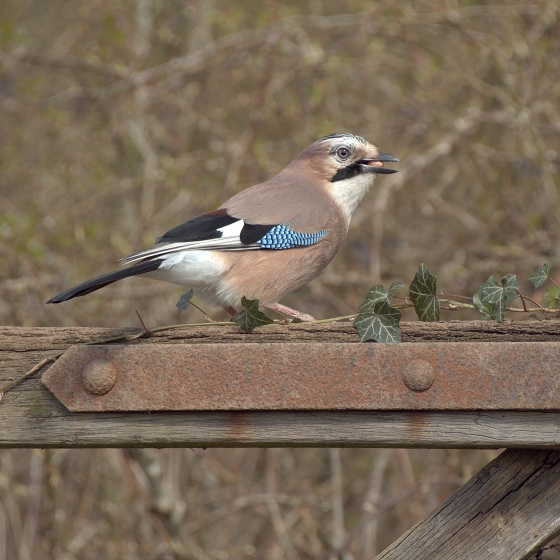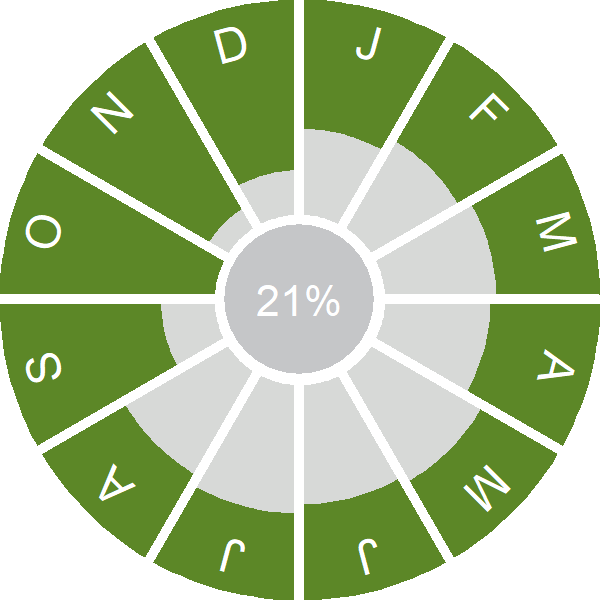Jay
Garrulus glandarius (Linnaeus, 1758)
J.
 JAY..
JAY..  15390
15390

Family: Passeriformes > Corvidae

A very colourful member of the crow family, Jays are often mistaken for something more exotic from warmer climes.
The pinkish plumage and striking blue and black barring on the wing make the Jay stand out from its neighbours. It has a bounding flight where its white rump is an easily noticed feature. Landing in a tree, the bird swoops up to a branch and then sits tight making it surprisingly hard to see when perched. Its raspy call can be the best indicator of its presence.
The Bird Atlas 2007-11 suggests that Jay distribution is constrained by woodland cover and climate. Recent surveys have shown the range of this species to be expanding to the north and west, particularly in Scotland and Ireland, although the fluctuating population numbers show no real trend up or down.
Exploring the trends for Jay
Our Trends Explorer will also give you the latest insight into how the UK's Jay population is changing.
trends explorerIdentification
Jay identification is usually straightforward.
SONGS AND CALLS
Listen to example recordings of the main vocalisations of Jay, provided by xeno-canto contributors.
Alarm call
Call
Song
Develop your bird ID skills with our training courses
Our interactive online courses are a great way to develop your bird identification skills, whether you're new to the hobby or a competent birder looking to hone your abilities.
Browse training coursesStatus and Trends
Population size and trends and patterns of distribution based on BTO surveys and atlases with data collected by BTO volunteers.
CONSERVATION STATUS
This species can be found on the following statutory and conservation listings and schedules.
POPULATION CHANGE
The UK Jay population remained stable in the species' preferred woodland habitat until the late 1980s, after which the population began to decline. This decrease followed an earlier decline on farmland CBC plots (Gregory & Marchant 1996). With the losses since the 1980s now regained, long-term trends are stable overall. The BBS map of change in relative density between 1994-96 and 2007-09 indicates that increases occurred almost everywhere during this period, with the exception of parts of central southern England. Mean brood size appears to have increased by half a chick since 1968, and nest success has also improved, so the number of fledglings per breeding attempt has increased, though all demographic measures are based on small samples. There has been an increase across Europe since 1980 (PECBMS: PECBMS 2020a>).
| UK breeding population |
No population change in UK (1967–2022) 
|
Exploring the trends for Jay
Our Trends Explorer will also give you the latest insight into how the UK's Jay population is changing.
trends explorerDISTRIBUTION
Jay distribution within Britain & Ireland is thought to be constrained by woodland cover and climatic conditions.
Occupied 10-km squares in UK
| No. occupied in breeding season | 2106 |
| % occupied in breeding season | 70 |
| No. occupied in winter | 2200 |
| % occupied in winter | 73 |
European Distribution Map
European Breeding Bird Atlas 2
Breeding Season Habitats
| Most frequent in |
Deciduous Wood 
|
Relative frequency by habitat
Relative occurrence in different habitat types during the breeding season.

DISTRIBUTION CHANGE
Jay's winter distribution has expanded since the 1981–84 Winter Atlas, with an 86% range expansion in Ireland and a 16% expansion in Britain, where there have been major gains in Scotland.
Change in occupied 10-km squares in the UK
| % change in range in breeding season (1968–72 to 2008–11) | +17.5% |
| % change in range in winter (1981–84 to 2007–11) | +19.4% |
SEASONALITY
Jay is recorded throughout the year but detections peak in autumn when birds disperse or are actively seen caching food for the winter.

Movement
Information about movement and migration based on online bird portals (e.g. BirdTrack), Ringing schemes and tracking studies.
An overview of year-round movements for the whole of Europe can be seen on the EuroBirdPortal viewer.
RINGING RECOVERIES
View a summary of recoveries in the Online Ringing Report.
Foreign locations of birds ringed or recovered in Britain & Ireland

Biology
Lifecycle and body size information about Jay, including statistics on nesting, eggs and lifespan based on BTO ringing and nest recording data.
PRODUCTIVITY & NESTING
Exploring the trends for Jay
Our Trends Explorer will also give you the latest insight into how the UK's Jay population is changing.
trends explorerSURVIVAL & LONGEVITY
View number ringed each year in the Online Ringing Report
Maximum Age from Ringing 
|
16 years 9 months 19 days (set in 1983) 
|
Typical Lifespan 
|
4 years with breeding typically at 2 year |
Adult Survival 
|
0.59  
|
Juvenile Survival 
|
0.6 (in first year) 
|
Exploring the trends for Jay
Our Trends Explorer will also give you the latest insight into how the UK's Jay population is changing.
trends explorerBIOMETRICS
Wing Length 
|
Adults | 181.1±6.2 | Range 171–191mm, N=1404 |
| Juveniles | 178±5.6 | Range 170-188mm, N=515 | |
| Males | 184.8±6.8 | Range 174–196mm, N=152 | |
| Females | 179.8±5.9 | Range 171–190mm, N=285 |
Body Weight 
|
Adults | 167±14 | Range 144–189g, N=1113 |
| Juveniles | 163±15.7 | Range 139–184g, N=417 | |
| Males | 172±14.3 | Range 146–197g, N=116 | |
| Females | 164±14.2 | Range 143–187g, N=234 |
Feather measurements and photos on featherbase 
CODES & CLASSIFICATION
Ring size 
|
D (pulli E) |
Field Codes 
|
2-letter: J. | 5-letter code: JAY.. | Euring: 15390 |
For information in another language (where available) click on a linked name
Research
Interpretation and scientific publications about Jay from BTO scientists.
CAUSES AND SOLUTIONS
Causes of change
There is little good evidence available regarding the drivers of the breeding population change in this species in the UK.
Further information on causes of change
No further information is available.
Information about conservation actions
The UK population of the Jay has been stable over the long-term and has increased over the last 25 years, hence it is not a species of concern and no conservation actions are currently required.
The drivers of change are not known and no specific conservation actions have been proposed for this species, although actions to maintain and restore woodland habitats to benefit declining woodland specialists may also benefit generalists including the Jay.
PUBLICATIONS (1)
Incorporating fine-scale environmental heterogeneity into broad-extent models
Links to more studies from ConservationEvidence.com
Would you like to search for another species?













Share this page